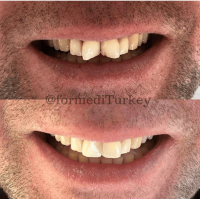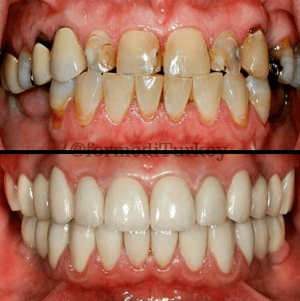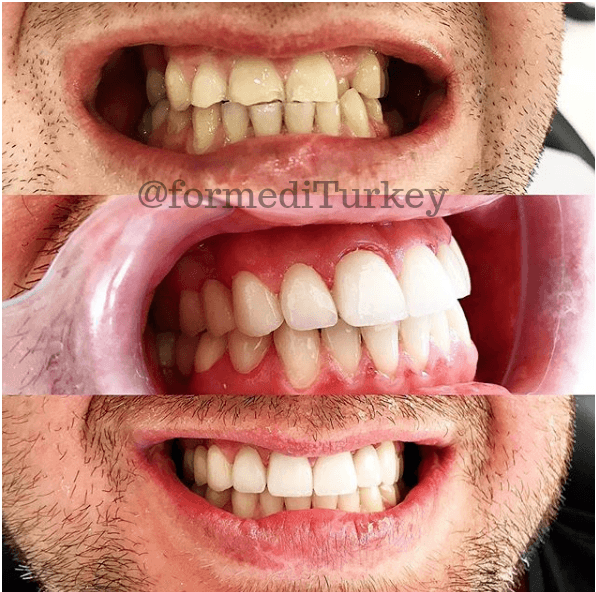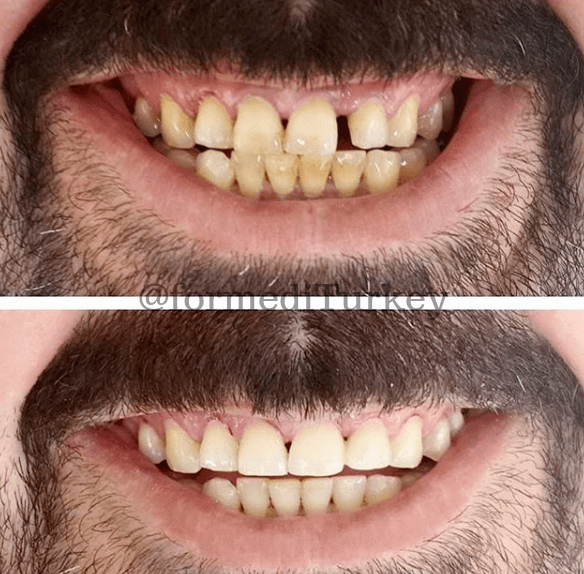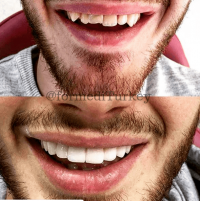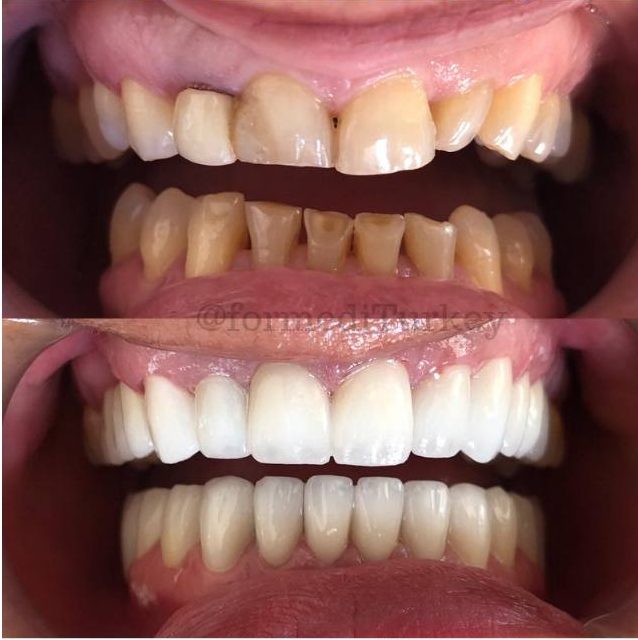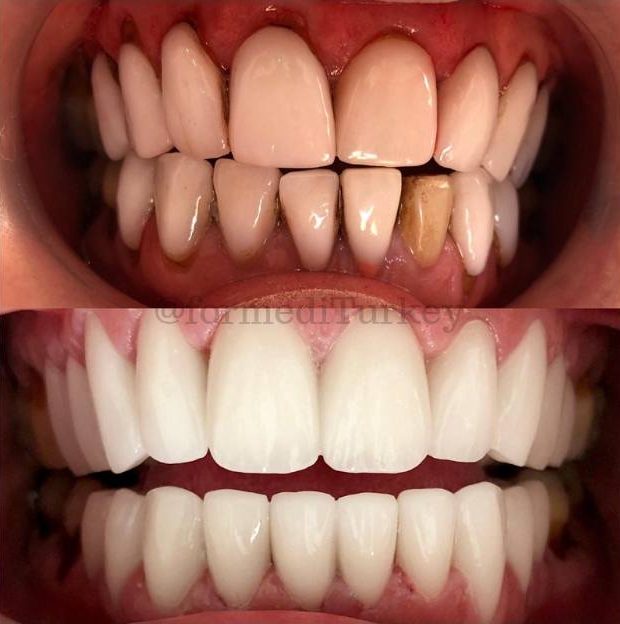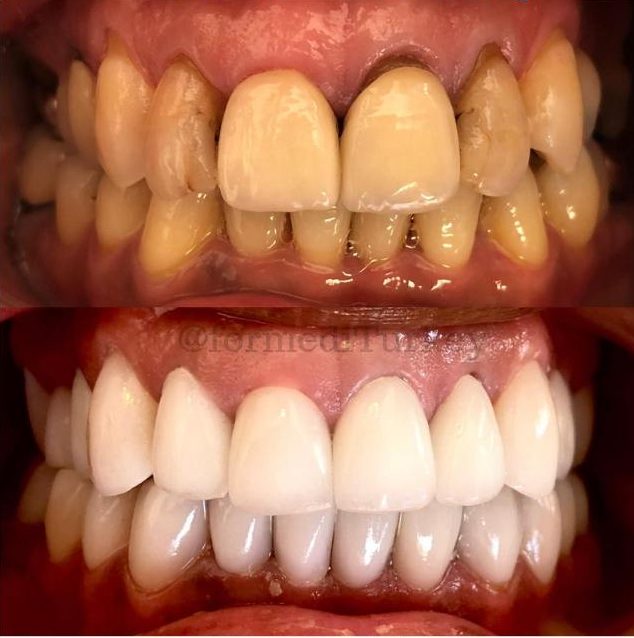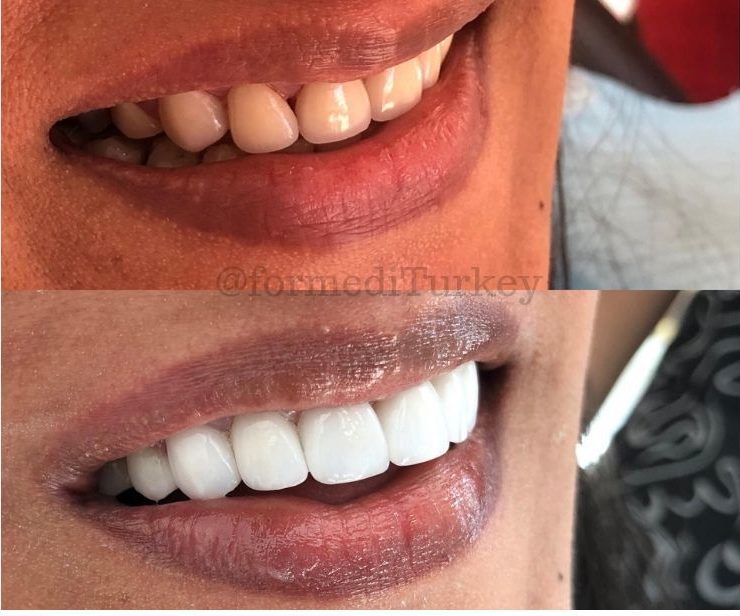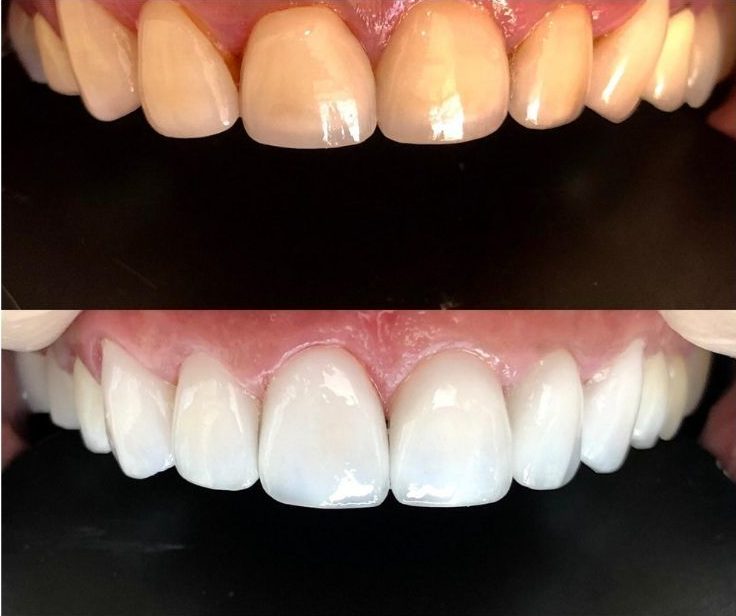
Dental Veneers Overview
Table of Content
- 1. Teeth veneers - What are dental veneers
- 2. Get the insurance for treatment abroad:
- 3. Veneers - Pros and Cons
- 4. Veneers candidate - When are veneers used?
- 5. Step by step veneer process
- 6. Dental veneers - what are the different types of dental veneers?
- 7. Full set of veneers
- 8. Have you already booked dental treatment abroad? Get protected for your trip.
- 9. How much do veneers cost?
- 10. Veneers Abroad - the best place to get veneers abroad
- 11. How long do veneers last?
- 12. Alternatives to Veneers
- 13. Veneers vs. Crowns
- 14. Veneers summary
- 15. Veneers before and after
- 16. Sources
Teeth veneers - What are dental veneers
In a nutshell, dental veneers are an extremely thin permanent covering that is placed over the front surface of your own teeth. They are usually made of a type of composite (that white material your dentist may use to fill your teeth) or different types of porcelain. They are custom-made for you and then bonded (glued) onto the surface of your own teeth. Normally they are only applied to the front teeth – those that can be seen when you smile. These thin covers can transform your smile and give your teeth that classic ‘film star’ look.
In fact, veneers were first invented in Hollywood in the late 1920s. They were used on film sets to give the actors a perfect smile. The problem was that the adhesive used to attach the veneers to the actors’ teeth was not that good and they soon came off. In the 1930s acrylic veneers became fashionable in the film industry. These were cemented on to the teeth but again were only designed to be a temporary fix. In the 1980s, it was discovered that hydrofluoric acid could be used to ‘etch’ the surfaces and this process was able to hold a veneer more permanently on the surface of a tooth.

A dental veneer is a very popular type of prosthetic restoration. It is a thin shell that is permanently glued to the front of the tooth, helping to achieve the desired effect of a perfect tooth
Since this time veneers have continued to evolve. The main focus for research has been the materials that veneers are made from, the bonding material/substance and how best to prepare the recipient’s teeth for the veneers. It is now widely accepted that veneers adhere best to the enamel on teeth rather than to dentine – the tooth substance under the enamel.
So, what are veneers for? Firstly, many of us do not naturally have straight, pearly white teeth. Added to this, we often mistreat our teeth. Smoking and drinking tea, coffee, red wine, and cola, among other things, can seriously discolor and stain the teeth. On top of this, some people use their teeth to open difficult things like bottles, cans, and bags and this can crack either our whole tooth or the enamel coating of the tooth as well as adding to the problem of crooked or misshapen teeth.
More often than not, tooth veneers are used for aesthetic reasons rather than as an emergency medical treatment. They can be used to hide small chips, cracks, and stains which have formed on the surface of the teeth. Teeth veneers can also sometimes correct misshapen teeth e.g. to slightly lengthen teeth which have been worn down, to close gaps between teeth or to rectify teeth that are not straight. They can hide a whole multitude of imperfections.
Sometimes just one veneer is required to straighten or repair a tooth, or to return a tooth to its natural color. If the purpose of the veneers, though, is to improve the color of your teeth (e.g. make them brighter) then a full set of veneers will be required to make sure that all your ‘visible’ teeth look the same. The minimum ‘full’ set of veneers is six teeth top and bottom. Depending on the visibility of your teeth when you smile, this may increase to eight or even ten teeth top and bottom.
Veneers - Pros and Cons

Veneers have advantages and disadvantages. They help to get the perfect smile and hide some imperfections. The biggest advantage of veneers is the instant and long-lasting effect
As with all dental procedures, the Internet can provide us with any number of wonderful stories about the results achieved by teeth veneers as well as many horror stories about veneers went wrong. Sometimes these negative stories are pure because people’s expectations of the outcome are not realistic. It always pays to consider the pros and cons of veneers before deciding whether this procedure is for you.
What are the benefits of veneers?
The obvious benefit of having veneers is that your teeth can look whiter and/or straighter – you will have a dazzling smile. There are some other possible procedures which may have the same effect, however, compared to many of these, veneers have the following benefits:
- They are long-lasting – depending on the type of veneer and how well they are looked after – between 5-15 years
- The procedure is relatively simple – usually requiring just two/three visits to the dentist
- They give the wearer a very natural look
- They do not stain easily
Unlike a crown or cap the veneer is only placed on the ‘front’ of your teeth – the part that is seen when we smile – this means that, in comparison with a crown or cap, much less of the ‘good’ part of the tooth has to be destroyed.
Disadvantages of veneers
It is very important that you are aware of the disadvantages of veneers, especially as the procedure cannot be reversed. If you don’t like them, can’t afford to maintain them or can’t afford to replace them, your affected teeth cannot be put back to the state they were in prior to the procedure. Bear in mind, however, that this situation applies to other dental procedures. Crowns, caps, and bridges all require some drilling or filing of your existing teeth and replacement from time to time.
- Often, a very small amount of enamel has to be shaved off the front of your tooth. This means that the procedure is non-reversible
- The veneers will have to be replaced after 5-15 years, depending on the type of veneers
- The ‘life’ of a veneer may be drastically shortened if you grind your teeth (bruxism)
- Successive veneer replacements will involve drilling more and more of your natural healthy teeth away
- Some people may find that their teeth become more sensitive to hot and cold temperatures, particularly for the first few days
Veneers candidate - When are veneers used?
A large percentage of people are suitable for teeth veneers. They are particularly helpful for the following problems:
Tooth discoloration: Tooth whitening is a simpler, cheaper and very effective solution for tooth discoloration, however, it does not always work on more severely stained teeth. Teeth veneers actually cover your teeth so stains and discoloration just disappear.
Small defects in your teeth: Small defects like chipped teeth and slightly crooked teeth or bad teeth alignment can sometimes be helped with dental bonding, however, veneers create a more natural appearance.
More than one dental problem: For those people with more than one of the above issues, veneers offer a ‘one-stop’ solution. Rather than paying for several procedures which may mean several visits to your dentist and sometimes quite painful or invasive treatment, teeth veneers offer a solution that is minimally invasive and requires only a few visits to the dentist.
The following are also important when you are considering whether to have dental veneers:

To be a good candidate for veneers patient teeth and gums should be generally in good condition which means there is sufficient tooth enamel and also teeth supposed to be quite straight
Healthy teeth and gums and good oral hygiene: Veneers will not make unhealthy teeth and gums healthy again – so it is essential that any restorative work on your teeth has already been done. Regular brushing and flossing will ensure that your natural teeth and the teeth veneers last as long as possible.
Sufficient tooth enamel: With certain types of veneers a very small amount of tooth enamel is shaved from your teeth and the tooth veneer subsequently bonded to the remaining tooth enamel. It is therefore essential that there is enough enamel on your tooth otherwise this bond cannot adhere properly to your own tooth and is likely to fall off.
Fairly straight teeth: Veneers can correct minor misalignments, however severely misaligned teeth or a misaligned bite (malocclusion) means that the veneers could crack and be spoilt very quickly. This happens because additional pressure is put on your teeth and therefore on the veneers.
Habitually putting undue pressure on your teeth: Bruxism or habitual tooth grinding also puts additional pressure on your teeth and may ruin the veneers. In addition, regularly chewing your nails, chewing ice or generally giving your teeth a hard time may drastically cut short the life of any veneers.
Step by step veneer process
So, if teeth veneers could be the answer to some of your dental issues, what exactly is the step by step veneer process?
For the most common type of veneers – porcelain veneers – the whole process from start to finish will require up to three visits to your dentist. Some dentists, particularly those overseas, may combine visits 1 and 2 so that only a total of two visits are necessary.
First Visit or Consultation
At this stage, the dentist will assess the condition of your gums and teeth and the general health of your mouth to ascertain that veneers are a suitable solution. They may also take impressions of your teeth and provide you with some kind of visual display of how your mouth will look after the treatment. This is the time to discuss with the dentist any questions or problems that you have, as well as making sure you are happy with your anticipated new dental look! If not already agreed, the cost of the work will also be discussed during this visit.

Veneers treatment require from the patient a few visits at the dentist which includes consultation, preparation of teeth and finally fitting the veneers. If the patient needs any root canal treatment or fillings change extra visits may be needed
Second Visit or Preparation
Some dentists may combine this visit with the first visit. During this visit, the dentist will remove a very thin layer of enamel from your tooth, usually about 0.5mm. There are no nerves in the enamel of your teeth so this should not be painful. However, if you wish, and depending on the amount of work to be done, the dentist may administer a local anesthetic. This very small amount of enamel needs to be shaved off your teeth so that the thin veneer will not feel too bulky in your mouth. It also means that the veneer can bond more strongly to a ‘rough’ surface rather than the smooth surface of our tooth enamel. The dentist may also take some more impressions of your teeth so that the technician who creates your veneers has all the necessary information to custom make the veneers to suit your mouth. The shape of our teeth is individual and is affected by hereditary factors such as our gender and ethnic background. Sometimes, at the end of this visit, temporary veneers may be fitted, but this is not always necessary.
Third Visit or Fitting
Once the veneers are returned from the laboratory, the veneers can be fitted to your teeth. Firstly, however, the dentist will check the fit, making sure that the alignment is OK and that the veneers don’t affect your bite pattern. The dentist can make any minor alterations to the veneers that are needed. Once you have both decided that your veneers are ‘perfect’ the fitting process can take place. This involves, firstly, giving the teeth, on which the veneers are to be fixed, a very thoroughly clean to ensure that there is no contamination present which could affect the bonding process. Next, an acid gel is applied to each of the affected teeth so that the enamel is microscopically roughened thereby providing a better surface for the bonding. A special cement is then applied to the back of each veneer which is attached to the appropriate tooth. Lastly, a curing light is applied to harden the cement and ensure a good bond between the tooth surface and the veneer. Some people may find that their gums are a little sore after the process but this should not last long.
Different veneers do have slightly different processes – these differences are highlighted in the next section on different types of dental veneers.
Dental veneers - what are the different types of dental veneers?
Composite Veneers
What are composite veneers?: Direct composite veneers are made from very thin layers of a tooth-colored resin which are bonded one-by-one to your tooth surface. This composite is then polished to give it a natural appearance. It is most suitable for minor repair work. Sometimes it is not necessary to remove any of the natural tooth enamel. Indirect composite veneers are made from the same material, however, they are not created locally by the dentist but in a laboratory.
Advantages:
- Often the treatment can take place during one visit (direct composite)
- The cost is less than for porcelain veneers
- No, or very little, tooth enamel has to be removed
- They are easier and cheaper to repair
- The process is reversible if no enamel has been taken off the tooth.
Disadvantages:
- They are not as strong as porcelain veneers and are more easily damaged
- They are only really suitable for minor repair work – maybe one or two slightly chipped teeth
- They are usually expected to last about 3-5 years
Porcelain Veneers
What are porcelain veneers? Porcelain veneers are the ‘gold standard’ when it comes to teeth veneers and these are the veneers most often offered by cosmetic dentists. They are made in a laboratory as per the measurements and impressions taken by the dentist and subsequently bonded to your teeth.
Advantages:
- They are strong and long-lasting – their expected lifetime is up to 10-15 years
- They look very natural and don’t stain very easily
- They are the least likely type of veneers to crack or break
- Your gums are very tolerant of porcelain
Disadvantages:
- They are more expensive than composite veneers
- Some enamel is taken off your own teeth, so you can never go back to your natural teeth
Zirconia Veneers
What are zirconia veneers? Zirconia veneers are similar to porcelain veneers, except that the porcelain contains about 90% zirconium oxide. This creates a very strong and durable veneer. They are thinner than normal porcelain veneers – about 0.2mm thick.
Advantages:
- Extremely hard-wearing – they may last up to 15 years
- As they are so thin, there may be no need to shave any existing enamel off the natural teeth
- Probably the most natural-looking veneers
Disadvantages:
- Cost – they are the most expensive types of veneers
Lumineers
What are lumineers? These are one of the newest types of tooth veneers and are expected to grow in popularity. Lumineers are ultra-thin veneers that require no removal of the tooth enamel. They are about 0.3mm thick. They are sometimes known as ‘no-prep’ or minimal-prep veneers. The fitting process is similar to porcelain veneers but with little preparation required.
Advantages:
- The patient retains their tooth enamel although the bonding process may affect the tooth surface
- Generally, the procedure is quicker
- The process is often reversible
Disadvantages:
- More expensive than traditional porcelain veneers
- They may not mask discolored teeth so effectively, because they are so thin
- As no enamel is taken off the teeth, some people may find them ‘bulky’
Clip-On Veneers
What are clip-on veneers? Clip-on or snap-on veneers can be put in or taken out of your mouth as required. They are made from dental resin and are a cost-effective option for dental cosmetic treatment. However, most dentists do not regard them as a long-term option. They may be a good choice for those people who still haven’t decided if they want veneers or not. They can be used as a ‘trial run’, without any alterations to your natural teeth. Beware cheap clip-on veneers which can often damage teeth and are difficult to eat with. The best clip-on veneers are those crafted to your own mouth/teeth specifications.
Advantages:
- They are much cheaper than traditional veneers
- There is no work required on the existing teeth
- They offer the opportunity to ‘try out’ veneers
- They are removable
Disadvantages
- Their durability is much lower than normal veneers
- They may feel bulky in the mouth – some people experience problems with eating and speaking
- They must be regularly taken out and properly cleaned
- They do not have the same look and feel as the porcelain veneers
Full set of veneers

‘The social six’- this term is used to determine the six teeth at the top and the six teeth at the bottom which shows when a person smiles. If a patient wants to have a so-called ‘Hollywood smile’ those teeth needs to be veneered
Do you need a full set of veneers? Most people want teeth veneers either to improve the appearance of a particular problematic tooth/teeth or in order to generally improve their appearance when they smile. So, individual teeth or multiple teeth may be veneered. Obviously, when only one, or a few teeth, are veneered, the veneer will have to match the current tooth color. This can be done with the aid of a teeth color chart. For a ‘white, Hollywood smile’, however, several teeth will need to be veneered and the color of the teeth can be changed. Dentists use the term – ‘the social six’ – to define the six teeth at the top and the six teeth at the bottom which are normally on show when somebody smiles. These are probably the minimum number of teeth that need to be veneered if you wish to brighten the color. Some people elect to just veneer their top teeth – again it is necessary to think about color, or there is always the option of a full set of veneers. With a full set, all teeth will look straight and the color will be consistent throughout your mouth. It is worth noting that veneers will not ‘whiten’ the teeth in the same way as the ‘teeth whitening procedure’ which dentists carry out, however they may brighten the teeth and give them a more uniform color.
How much do veneers cost?
The cost of veneers is dependent on three main factors:
- Firstly and probably most importantly, the type of veneers that you wish to have.
- The number of teeth which require veneers.
- The amount of treatment that may or may not is required to ensure your teeth are in the best possible condition prior to the veneer procedure.

Cost of the treatment depends on a few factors, a number of the veneers, the material from which they are made or if any additional treatment like root canal has to be performed before fitting them
As a ballpark figure, in the UK the cost for composite veneers is £200-£500 and for porcelain veneers between £400 and £1000 per tooth. USA costs start at $250 for composite veneers and $1000 for porcelain veneers. If you are looking for a set of pearly white straight teeth, remember that you will probably need at least 6 teeth treated on the top and the bottom and sometimes even more. The price for one tooth falls proportionately when more than one tooth is veneered. As with everything in life, it pays to shop around. However, remember that this is a medical procedure and therefore the experience and qualifications of the dentist are important. If possible, go with the recommendations of other people who have had this procedure. The Internet abounds with stories of disastrous veneer experiences. This, of course, represents only a very small percentage of the procedures carried out each year, but it pays to be careful.
Here’s a price-list from one of the most trustworthy medical services facilitator, WhatClinic:
[table id=40 /]
How much do veneers cost on the NHS?
Teeth veneers are essentially a cosmetic procedure, which, under normal circumstances, are not available on the NHS. In exceptional cases, where chipped teeth, cracked teeth or misaligned teeth are causing considerable pain, the NHS may consider paying the costs. In England, if it is agreed that your veneer(s) is a medical need rather than a cosmetic need then it falls into the NHS Band 3 charges and you will be required to pay £269.30. NHS Scotland and NHS Northern Ireland have a cap of £384 and NHS Wales £199.10. All of these health services provide free dental treatment for:
- those under 18, or under 19 and in full-time education
- women who are pregnant or have had a baby in the previous 12 months
- if you are treated in an NHS hospital and your treatment is carried out by the hospital dentist
- if you receive low-income benefits, or you’re under 20 and a dependant of someone receiving low-income benefit
Many people in the UK now have their own private dental insurance, but again these companies only usually provide reimbursements for teeth that require structural improvements from decay, tooth wear or fracture. They do not normally provide cover for cosmetic treatments like veneers or adult orthodontic procedures which simply align the teeth to look better. If you do have such an insurance policy, it is, of course, worth checking with your insurance company as conditions do vary from company to company.
Veneers Abroad - the best place to get veneers abroad
Many countries can offer the same quality tooth veneers cheaper than in the UK. Savings of more than 50% are not unrealistic. However, similarly to treatment in the UK, it pays to check the qualifications and experience of the dentist/clinic and to consider recommendations from other people. The three most widely used countries for teeth veneers abroad are Turkey, Hungary, and Poland. Prices for veneers abroad are affected in the same way as UK prices, depending on the type of veneer required and how many teeth need to be veneered. They also vary from dentist to dentist.
A dental visit abroad for a veneer procedure requires a stay of 5 days, as there will be a short wait while your veneers are made in the laboratory. Rather than staying abroad for 5 days – Monday to Friday – it is sometimes possible to make two one day visits. For a full set of veneers, some dentists will pay or part pay accommodation and flight costs. What’s also important, patients can get secured for their medical trip, which makes their travel and stay abroad much safer. Clinic Hunter & AXA Partners have created medical insurance for overseas dedicated solely to medical tourists.
Veneers in Turkey – how much are veneers in Turkey?
Porcelain veneers in Turkey start from about £200 for one tooth, with the average price closer to £250 for one tooth. A full set of veneers (10 teeth on the upper jaw and 10 teeth on the lower jaw) starts from around £5000. The popularity of Turkey as an inexpensive location for dental treatment is growing. Generally, dental surgeries are well-equipped and dentists speak English. One attraction of Turkey, aside from its prices, is the possibility of spending a week on the Mediterranean or Aegean coasts – the possibility of a suntan in addition to a new smile!
Veneers in Hungary – how much are veneers in Hungary?

Poland, Hungary and Turkey are very popular destinations in medical tourism. By getting veneers, in Hungary, the savings can reach even 70 % comparing to the UK. Veneers in Hungary start from about £250 for one tooth
Hungary is now known as ‘the dental capital of Europe’. Veneers in Hungary start from about £250 for one tooth. Costs are generally 50-70% less than in the UK. Many dental surgeries in Hungary are kitted out with the latest technologically-advanced equipment, with some even having their own dental laboratories. Dentists are well-qualified and most speak good English so there are no language barriers. In addition, many dental clinics are situated in Budapest, one of the most beautiful cities in Europe. So, not only can you create your perfect smile, but in the same trip marvel at Buda Castle, enjoy a cruise on the River Danube and relax in the Budapest baths fed from thermal springs.
Veneers in Poland – how much are veneers in Poland?
In the popularity of European dental venues, Poland comes a very close second to Hungary. Veneers in Poland start from about £200 for one tooth. Clinics are equipped with the latest X-ray machines and have their own laboratories, where they can quickly prepare your veneers. To many people’s surprise, the majority of the dental clinics in Poland are better equipped and furnished than some of their counterparts in Western Europe. Dental clinics are situated in many cities in Poland, but if you’re looking to combine your treatment with a holiday it’s worth bearing in mind that Krakow has just been voted the Best City Break Destination for the third year in a row. (Budapest also scored highly coming in at No. 6). In addition, budget airlines offer a wide range of flights at very reasonable prices from many provincial airports in the UK as well as from many other airports in Europe.
The actual price you pay may be very different depending on the initial state of your teeth and gums. It is always advisable to send -rays to the dentist overseas so that they can give you a more exact cost for your personal circumstances.
How long do veneers last?
It is difficult to give a definitive and precise answer to this question. The longevity of the veneer is subject to many factors – including what you eat, how you eat and general oral hygiene. In addition, the veneers may need to be replaced for aesthetic reasons – as we age our gums recede so it is possible that the line of the veneer may become visible as time goes on. The following table gives the average expected length of time you may expect your veneers to last:
[table id=11 /]
Research has found that factors which particularly influence the survival of porcelain veneers include patient gender, patient age, changing dentist, patient’s treatment need, patient charge-paying status, and geographical area.
How to take care of dental veneers
For all of the veneer types good maintenance is essential to prolong their life for as long as possible. This includes:
- Practicing good oral hygiene, including brushing and flossing.
- Attending regular check-ups with your dentist. He/she may be able to spot any issues with the veneers and rectify them immediately.
- Treating your veneers with respect – although very durable, like your own teeth, they can chip or crack when you chew on hard objects like ice, pens, fingernails, etc.
- If you grind your teeth (bruxism) you need to wear a bite guard at night. (Most dentists will not recommend veneers if you suffer from bruxism)
- For those veneers where enamel has not be taken from the tooth, the veneer may jut out slightly from the gum. Make sure that the area between the gum and the veneer/tooth is kept clean.
Alternatives to Veneers
There may be cheaper alternatives to veneers which will solve your dental issues just as well.
Teeth Whitening
Teeth whitening is a sensible alternative to veneers if you wish to only address the issue of the tooth discoloration. Although home kits are available these can be risky, so for a perfect set of white pearlies, it is always better to get the procedure done by a dentist. Teeth whitening does, however, have its limitations. The teeth whitening procedure bleaches your teeth so that they are several shades lighter than before. Depending on the color of your teeth to start with, this doesn’t necessarily mean that the end result is a brilliant white color. It also needs to be performed on a regular basis to maintain the whiteness.
A US company DMG have recently introduced ICON treatment. This is a minimally invasive treatment that can help to diminish white and brown spots on the teeth. The treatment was originally created to treat tooth decay at its very earliest or ‘white spot’ stage. However, it was discovered that it was also very useful as a stain removing (and therefore brightening) agent. It does not weaken the tooth at all and may even strengthen it. For bad stains, it is used in conjunction with tooth whitening.
Veneers cannot be whitened, but if you want your white veneers to be more of a match to your natural teeth, you will need to whiten your natural teeth before the veneer procedure and periodically afterward.

If the patient can not be qualified for veneers due to different reasons, there are many other alternatives like braces treatment, teeth recontouring or Invisalign which the dentist may offer to improve the visual look of teeth
Orthodontics
For maligned teeth or malocclusion, orthodontics, like braces may be a better alternative. In recent years, the look and feel of braces have changed considerably. There are now alternatives to the old-style metal train track braces e.g. ceramic braces with white, clear or even tooth-colored wires or even near-invisible teeth aligners like Invisalign. Your dentist will be able to tell you what type of braces would be best for your situation. On the downside orthodontics may take longer to change the visible appearance of your teeth, however, at the end of the treatment, the change is usually permanent. With veneers, misaligned teeth are just covered.
Invisalign
The Invisalign System, designed and manufactured by Align Technologies Inc is an innovative system that works in a similar way to dental braces. They are clear, near-invisible, remover aligners that fit over your teeth and gradually correct problems such as deep bite, open bite, underbite, crossbite, gapped teeth, and overly crowded teeth. They are custom-made for each customer and are changed on a regular basis (every one to two weeks). Typically the whole process takes 14-18 months (usually 25-30 aligners changed at fortnightly intervals), but depending on the severity of the condition may take less time or more time. The price of treatment for adults is often between £2,500 and £5,500.
Tooth Recontouring
Tooth recontouring cannot help with discoloration or misalignment, however, if you are generally unhappy with the shape of your teeth then recontouring may be able to help. It usually involves just one visit to the dentist, who can generally improve the shape and texture of the tooth. On the upside the results are permanent, however, there is a limit as to how much the dentist can do using this method.
Dental Bonding
Dental bonding is another name for direct composite veneers. These are veneers that are built up in very thin layers on the tooth enamel by your dentist, rather than being produced in a laboratory and then bonded to the teeth. Chipped, cracked or discolored teeth can be treated with dental bonding. The treatment is fast and relatively inexpensive and it only affects the part of the tooth where the problem lies. Dental bonding may not last as long as indirect veneers but it is fairly easy and cheap to repair.
Veneers vs. Crowns
A veneer is a very thin covering that is bonded only to the front surface of your tooth. A dental crown is much thicker and completely covers your tooth at the front top/bottom and back.
If the purpose of the treatment is purely cosmetic then veneers are a better solution than a crown. When a tooth is not in a good condition i.e. it has a large filling, has had or is having root canal treatment, or has a part missing, then a crown is probably the best course of treatment. A crown involves removing quite a lot of your tooth so that it can sit unobtrusively on the top of the much-reduced tooth. Generally, a crown will be more expensive than veneers and it is more invasive.
Veneers summary
Teeth veneers are a quick and relatively simple method of improving the overall appearance of your teeth. Veneers can offer small or more dramatic changes to your smile, which can drastically improve your self-confidence. In many cases, however, they are not the most inexpensive procedure available. Depending on the veneer, the effects (veneer) will last up to twenty years, at which stage it will need to be replaced, especially in cases where some of the tooth enamel has been removed. The wonderful aesthetic results often achieved, do come at a cost and it is advisable to choose the dentist for your procedure wisely. Treatment abroad, usually with exactly the same products as in the UK, can be a good option. Our knowledgeable consultants at ClinicHunter can recommend overseas dentists, advise you of their experience and put you in touch with other patients who have had treatments at a particular overseas dental surgery. Don’t take unnecessary risks with your dental health.
Veneers before and after
Please see the photos of dental veneers before and after of our previous patients.
Sources
https://www.nhs.uk/common-health-questions/dental-health/what-is-included-in-each-nhs-dental-band-charge/
Pini N. P. et al.‘Advances in dental veneers: materials, applications, and techniques’. Clin Cosmet Investig Dent. 2012; 4: 9–16.
https://www.ncbi.nlm.nih.gov/pmc/articles/PMC3652364/
Alothman Y., Bamasoud M. S. ‘The Success of Dental Veneers According to Preparation Design and Material Type’. Open Access Maced J Med Sci. 2018 Dec 20; 6(12): 2402–2408.
https://www.ncbi.nlm.nih.gov/pmc/articles/PMC6311473/
Nalbandian S., Millar B. J. ‘The Effects of Veneers on Cosmetic Improvement’. Br Dent J207, E3 (2009) doi:10.1038/sj.bdj.2009.609
https://www.nature.com/articles/sj.bdj.2009.609
B.T. Rotoli, DANL Lima, N.P. Pini, FHB Aguiar, GDS Pereira, and LAMS Paulillo (2013) Porcelain Veneers as an Alternative for Esthetic Treatment: Clinical Report. Operative Dentistry: September/October 2013, Vol. 38, No. 5, pp. 459-466.
https://www.jopdentonline.org/doi/full/10.2341/12-382-T
Burke F. J. T., Lucarotti P. S. K. ‘Ten-year outcome of porcelain laminate veneers placed within the general dental services in England and Wales’. Aims, Methods, Results, and Conclusions
https://www.sciencedirect.com/science/article/pii/S0300571208001061
Zhao J., Wang X. in ‘Advanced Ceramics for Dentistry, 2014 Chapter 3.2.2 Laminate Veneers
https://www.sciencedirect.com/topics/engineering/veneers
Send request to the best doctors abroad

Tina
Patient Advisor
Patient Advisor














































